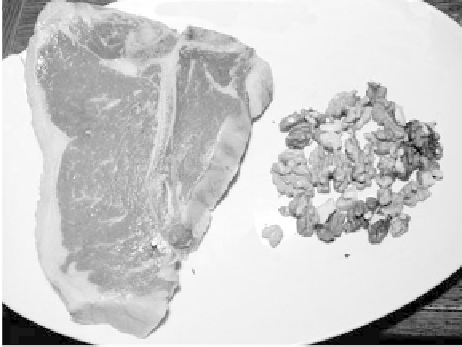Agriculture Reference
In-Depth Information
Figure
2.9.
Chemical structure of amino acids and bonding (connection) between them used
to form proteins. Two amino acids bonded together would be a dipeptide.
body cannot function. In Figure 2.9 a simple amino acid and two simple amino acids
bonded together are shown. In a protein or muscle a long chain of different amino
acids are bonded together in a similar way. In addition to muscle, all enzymes,
which are the body's catalysts, are made of proteins. They also often contain one or
more metal ions, which explains, in part, the importance of minerals in the diet. The
shape and function of the protein depends upon its amino acid composition.
Two examples of major sources of high-quality protein in the diet are meats and
nuts. Examples, steak and walnuts, are shown in Figure 2.10. Typically people eat
far more meat than nuts. One possible exception might be peanuts, which are eaten
in a number of different ways and as parts of meals in several regions in the world, par-
ticularly parts of Africa and India. Like meats, nuts are also a source of fat in the diet
(see Section 2.5).
Proteins are made up of a variety of amino acids that can be classified as either
nonessential or essential. Nonessential amino acids, listed in Table 2.3, are not essential
Figure
2.10.
Two high-quality protein sources, beefsteak, left, and walnuts right.


























































